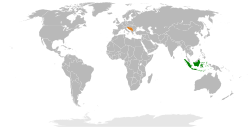Indonesia–Yugoslavia relations were historical foreign relations between now split-up Socialist Federal Republic of Yugoslavia and Indonesia. Both countries were founding member states of the Non-Aligned Movement. Two countries established formal diplomatic relations in 1954.[1] First diplomatic documents were exchanged as early as 1947.[2] Breakup of Yugoslavia, one of the founding and core members of the Non-Aligned Movement, brought into question the very existence of the Movement which was preserved only by politically pragmatic chairmanship of Indonesia.[3]
YouTube Encyclopedic
-
1/5Views:36 306433 5431 094 5791 601 1421 795 128
-
Indonesia 🇮🇩 Relations With Different Countries
-
Indonesian War of Independence - COLD WAR DOCUMENTARY
-
Why is Croatia split in two by Bosnia? (Short Animated Documentary)
-
Why Each NATO Member Joined #nato #military #facts
-
Why did the world let India annex Goa? (Short Animated Documentary)
Transcription
History



President of Indonesia Sukarno visited Yugoslavia on multiple occasions in 1956,1958,1960,1963 and 1964 while President of Yugoslavia Josip Broz Tito visited Indonesia in 1958 and 1967.[2] During Sukarno's first visit in 1958 Yugoslav diplomacy perceived its guest (earlier host of the Bandung Conference) as an invaluable dialogue partner in the context of the Poznań protests of 1956, Suez Crisis, President Tito meeting with Nikita Khrushchev and the meeting between Tito, Indian Prime Minister Jawaharlal Nehru and President of Egypt Gamal Abdel Nasser on Brijuni Islands.[4] During the 1964 visit to Belgrade Yugoslav side voiced its concerns over the Indonesia's support of what Belgrade perceived the militant Chinese Communist views on how to settle world problems contrary to Five Principles of Peaceful Coexistence.[5]
Contrary to some other non-aligned countries which during the breakup of Yugoslavia provided diplomatic support to Federal Republic of Yugoslavia (Serbia and Montenegro), Indonesia provided its primary support to the Republic of Bosnia and Herzegovina, Yugoslav successor state with significant Muslim population affected by the Bosnian War. During the May 1998 riots of Indonesia which led to Fall of Suharto and subsequent end of Indonesian occupation of East Timor some analysts raised concerns that events may lead to dissolution of the country similar to violent breakup of Yugoslavia.[6]
See also
- Yugoslavia and the Non-Aligned Movement
- Indonesia–Serbia relations
- Croatia–Indonesia relations
- Bosnia and Herzegovina–Indonesia relations
- 1956 Croatia v Indonesia football match
- Death and state funeral of Josip Broz Tito
Further reading
- "Friendly Relations: Indonesia-Yugoslavia". (1958). Ministry of Information of the Republic of Indonesia.
- Ljubodrag Dimić, Aleksandar Raković and Miladin Milošević. (2014). "Yugoslavia and Indonesia, Tito and Sukarno 1945-1967". Archives of Yugoslavia & Archive of the Ministry of Foreign Affairs of the Republic of Serbia & Embassy of the Republic of Indonesia in the Republic of Serbia & National Archives of the Republic of Indonesia.
References
- ^ "Bilateral Issues: Indonesia". Ministry of Foreign Affairs (Serbia). Retrieved 29 August 2020.
- ^ a b "PRESENTATION OF COLLECTED PAPERS YUGOSLAVIA – INDONESIA". Archives of Yugoslavia. Retrieved 29 August 2020.
- ^ Schiavone, Giuseppe (2008). International Organizations: A dictionary and directory (Seventh ed.). Palgrave Macmillan. p. 250. ISBN 978-0-230-57322-2.
- ^ Ljubodrag Dimić, Aleksandar Raković and Miladin Milošević (2014). ЈУГОСЛАВИЈА И ИНДОНЕЗИЈА ТИТО И СУКАРНО 1945–1967. Прилог историји несврстаности. Archives of Yugoslavia & Archive of the Ministry of Foreign Affairs of the Republic of Serbia & Embassy of the Republic of Indonesia in the Republic of Serbia & National Archives of the Republic of Indonesia.
- ^ "SUKARNO TO SEE TITO ON DISPUTE; Plans Talks in Yugoslavia on Rift Over Coexistence". The New York Times. Retrieved 29 August 2020.
- ^ Cribb, Robert (1999). "Not the Next Yugoslavia: Prospects for the Disintegration of Indonesia". Australian Journal of International Affairs. 53 (2): 169–178. doi:10.1080/00049919993944.




